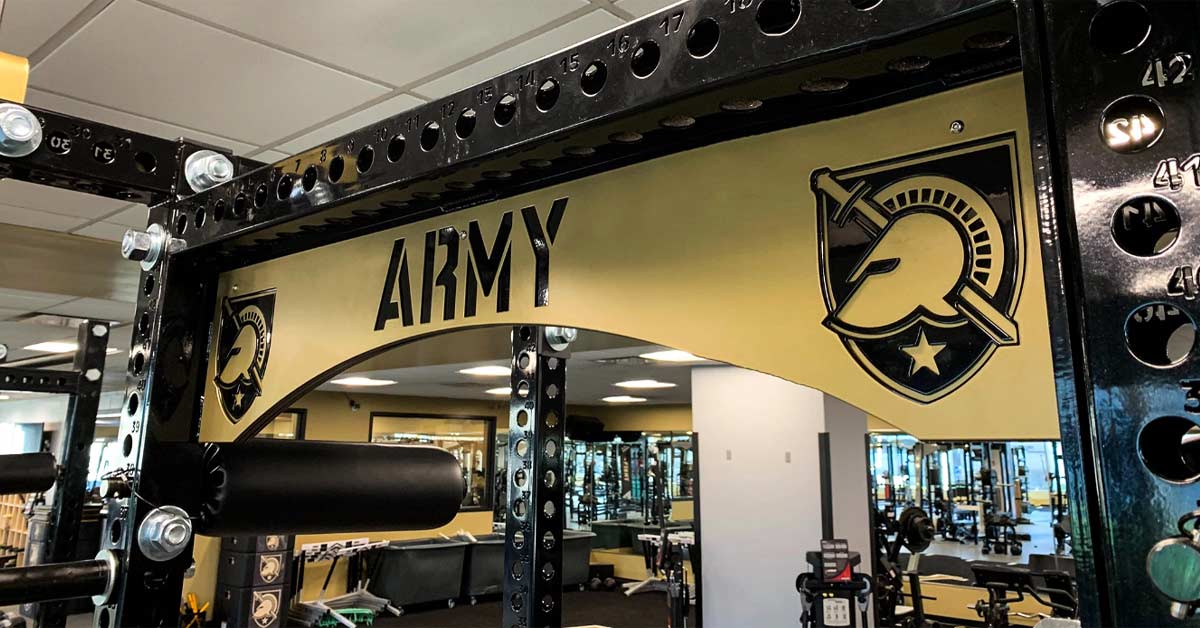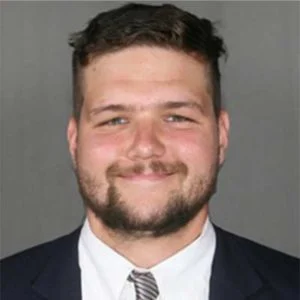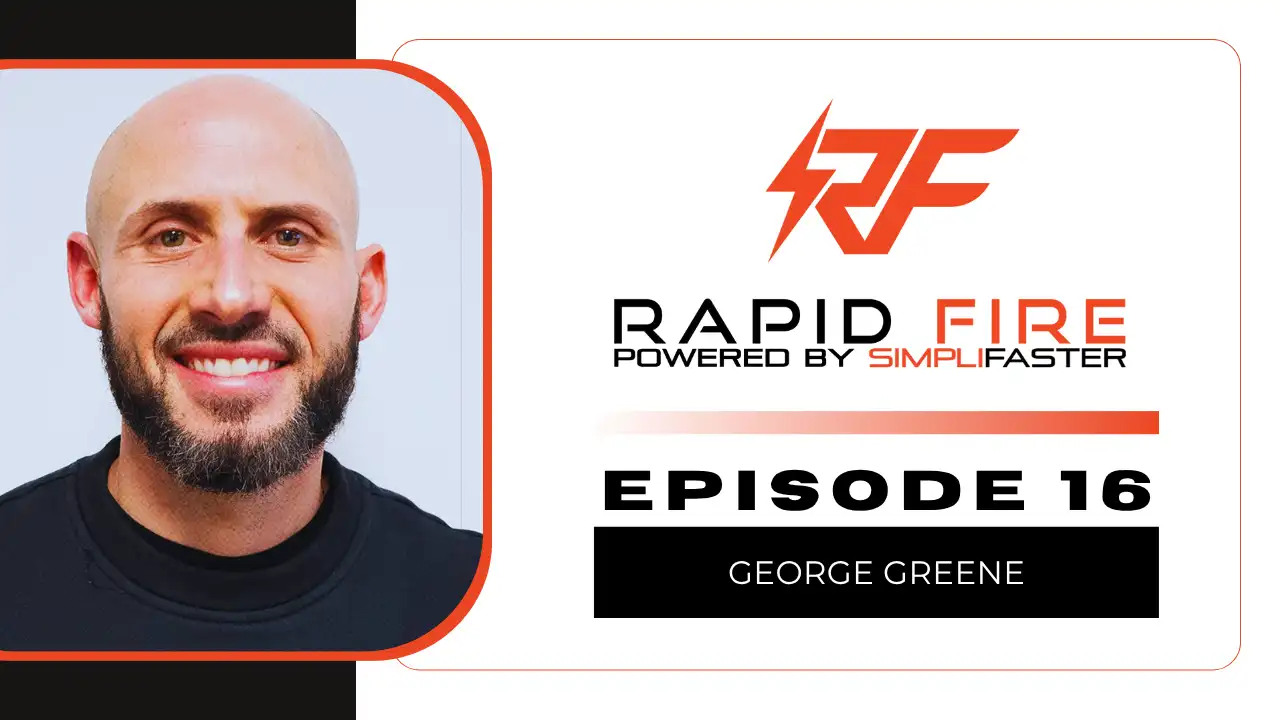Welcome back to another episode of Facility Finders. I have a gem of a facility for you this month. I reached out to the man in charge of training some of the future protectors of our great country, Coach Conor Hughes from Army Football in West Point, New York.
This episode is special for me, because I have wondered how one of the last teams in the country to still run the triple option is able to train to run that offense at a high level while also training the future soldiers of the United States of America.
Design and Purchasing
The O’Meara, Malek, Dawkins, Class of 1959 Strength Development Center is 20,000 square feet split into a large main training space with 28 racks and a 60-yard turf area, a turfed multi-use area, and a nutrition area. Initially, I thought why such a big space for a football team to train? Then Coach Hughes reminded me that he isn’t just training football players but also cadets.
Their schedules are incredibly packed and intense. It requires elite planning for a team to be able to do sprinting and plyometrics in the same building as their strength training, but it was a necessity for Army to be able to train the number of guys in the timeframe they do and still have space for a nutrition station.
“The biggest thing we needed was space and racks,” Coach Hughes explained. “With the time restrictions the cadets are under, we need to be able to handle large groups of athletes all lifting at the same time. That is why we try to have everything our athletes need for the workout right there on their rack. If we have a group of 100 guys lifting at once, whatever piece of equipment we are using we need to have 20 of.”
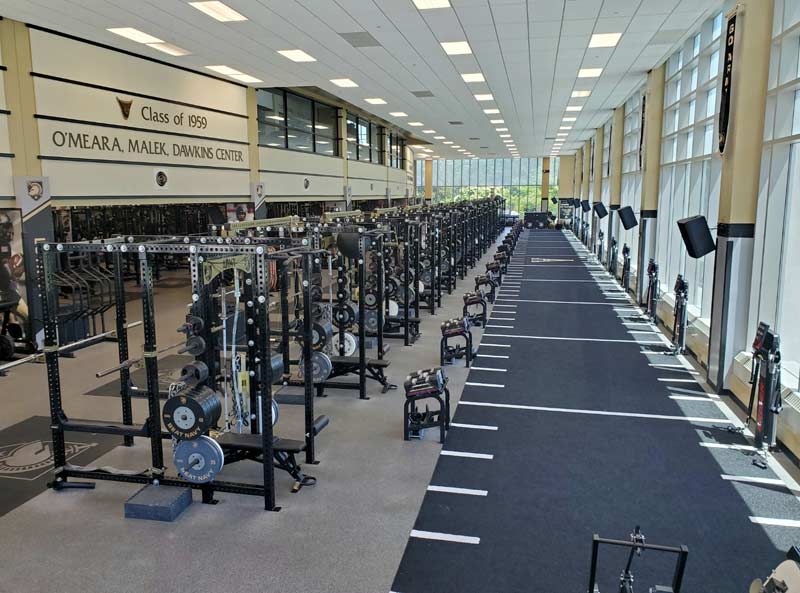
Another planning marvel that Army had to figure out was how to make this second-story weight room work effectively. Yes, I said it, this beauty is not on the bottom floor of the building. This was something completed before Coach Hughes arrived at West Point, but for the program to have the most maximized space, it was a necessity. The logistics behind this design came from the partnership they created with PLAE flooring.
Another planning marvel that Army had to figure out was how to make this second-story weight room work effectively. The logistics behind this design came from a partnership with PLAE flooring. Share on X“The weight room on the second floor produces its own set of challenges, with our locker room and our athletic training room underneath it—every time we dropped a clean, it sounded like a bomb going off in those two areas,” Coach Hughes said. “We worked with PLAE to develop a unique system, which is multiple layers of different thicknesses of foam for our clean drop zones, our platforms, and our turf space, so under our floor is about 8 inches of foam padding. PLAE has been outstanding throughout the entire process. Anytime there is an issue with the floor, PLAE comes and immediately fixes it.”
When deciding what racks to go with, Army chose to partner with Sorinex Exercise Equipment out of Lexington, South Carolina. This was a simple choice because of the quality that comes with Sorinex and their ability to create what needs to happen at that rack. The ability to add things like jammer arms and different pull-up handles or even to squat in the power rack and clean on the platform allows for guys to be constantly moving. Also, the purchasing power that comes with Sorinex is next-level; because of the size of the space, Army will not ever buy just one of something, they will need 20+. So, they need someone to be able to handle that type of volume.
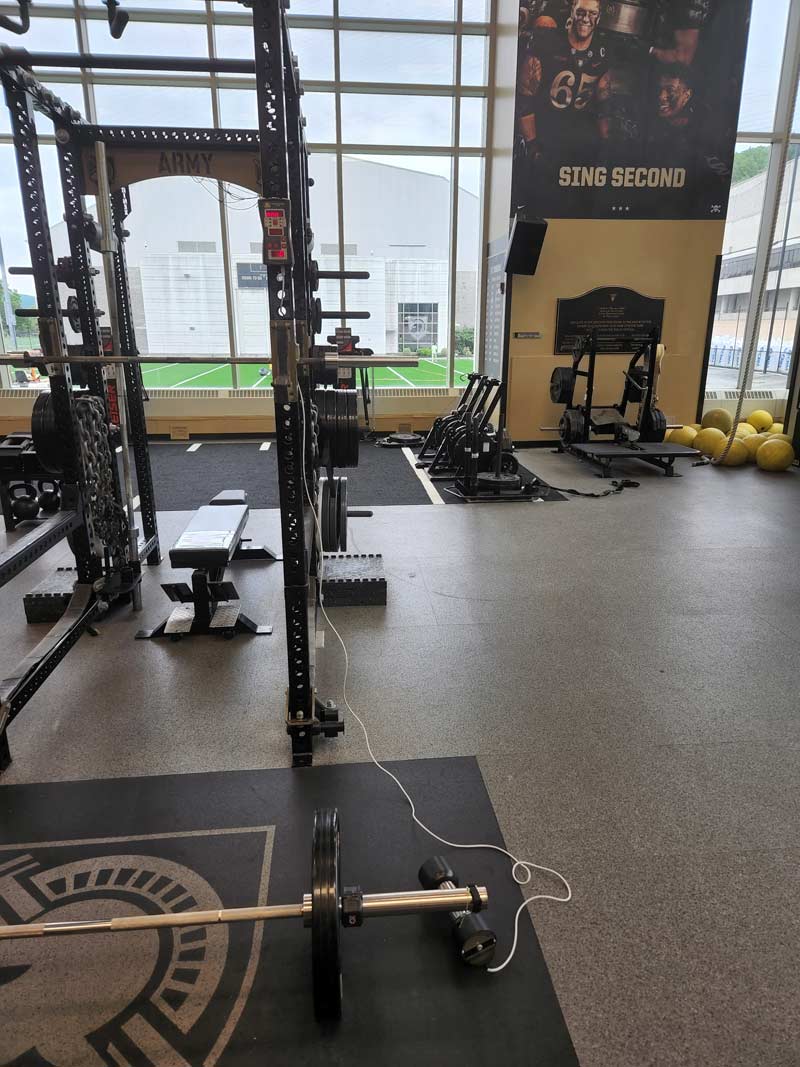
Specialty Equipment
Coach Hughes told me that with the different training cycles his guys go through, supporting the ability to run the triple option at a nationally ranked level means needing special equipment and A LOT of it. He talked about the Run Rockets, Tendo units, and PowerBlocks that go up to 175 pounds (I need to get my hands on those), Keiser functional trainers, and specialty bars like the Kabuki Safety Bar, as well as different training bars (Olympic and Power bars). The crazy thing is that EVERY rack has all this stuff—that way, those 4–5 athletes have access to everything they need for their program in that space.
This is the streamlined process that it takes to train effectively and efficiently at the high level as they do. The Run Rockets are an ideal product to use to help you train speed indoors: the resisted sprint not only helps in acceleration but also enables athletes to run without needing 80–100 yards of turf and can be used to help train things like sprint mechanics or even crawls.
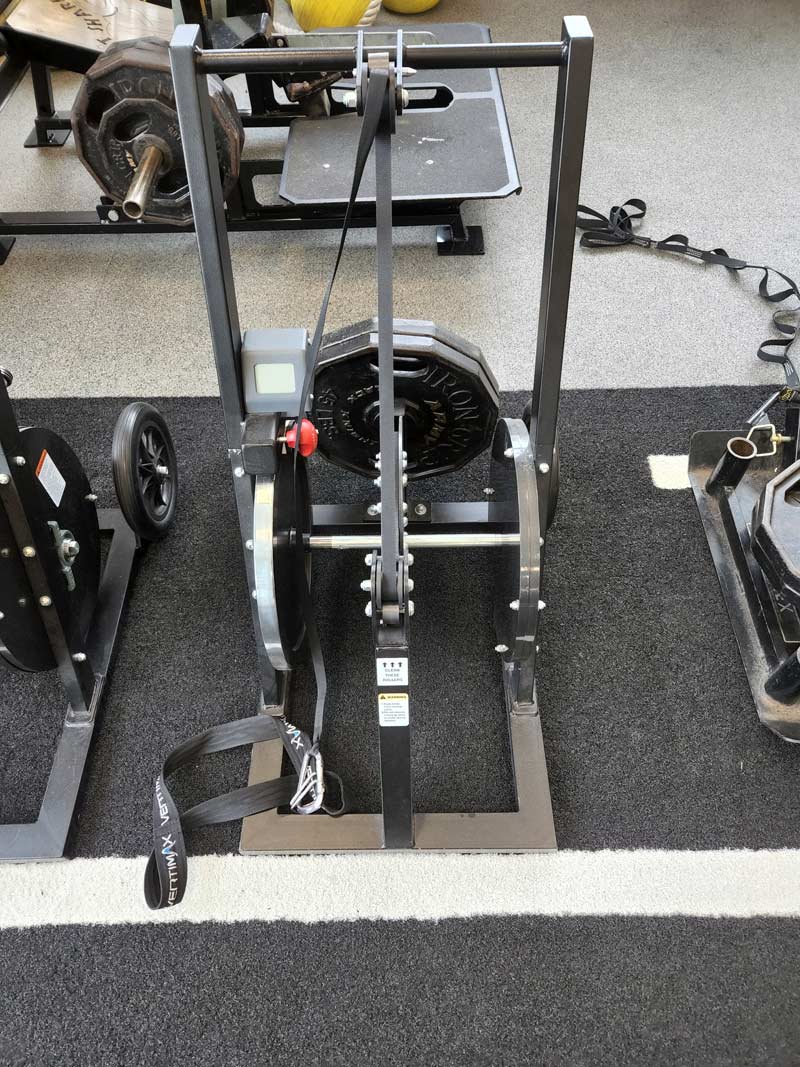
“Our Kabuki bars have been outstanding for us to do any hand-assisted type squats, but also for our guys with an upper-body injury to be able to train the lower body,” Coach Hughes said. “The Tendo units we only really use when we are doing our secondary squatting and benching movements, and it is a dynamic effort movement. KISS principle the majority of the time—we give them a percentage and a speed and say move it faster than X, and they will adjust the weights up or down based on the speed. The Keisers are a huge space-saver for us; they are easy to set up and the exercise selection opportunities are endless.”
Finally, the unique pieces of equipment in this weight room are the BEAT NAVY training plates. This is a rivalry that has stood the test of time and continues to this day. This, like anything, is a choice that is made to serve a specific purpose—for Army, the plates deliver a daily reminder to handle business and beat Navy.
“You cannot walk 50 feet at West Point without seeing Beat Navy; it is the best rivalry in sports,” Coach Hughes adds. “That game is electric. Every game on our schedule is important, but the Army-Navy game is the highest of highs when you win it, and the lowest of lows when you lose it. Everyone involved with Army football has to bring a Beat Navy mentality to every task they do.”
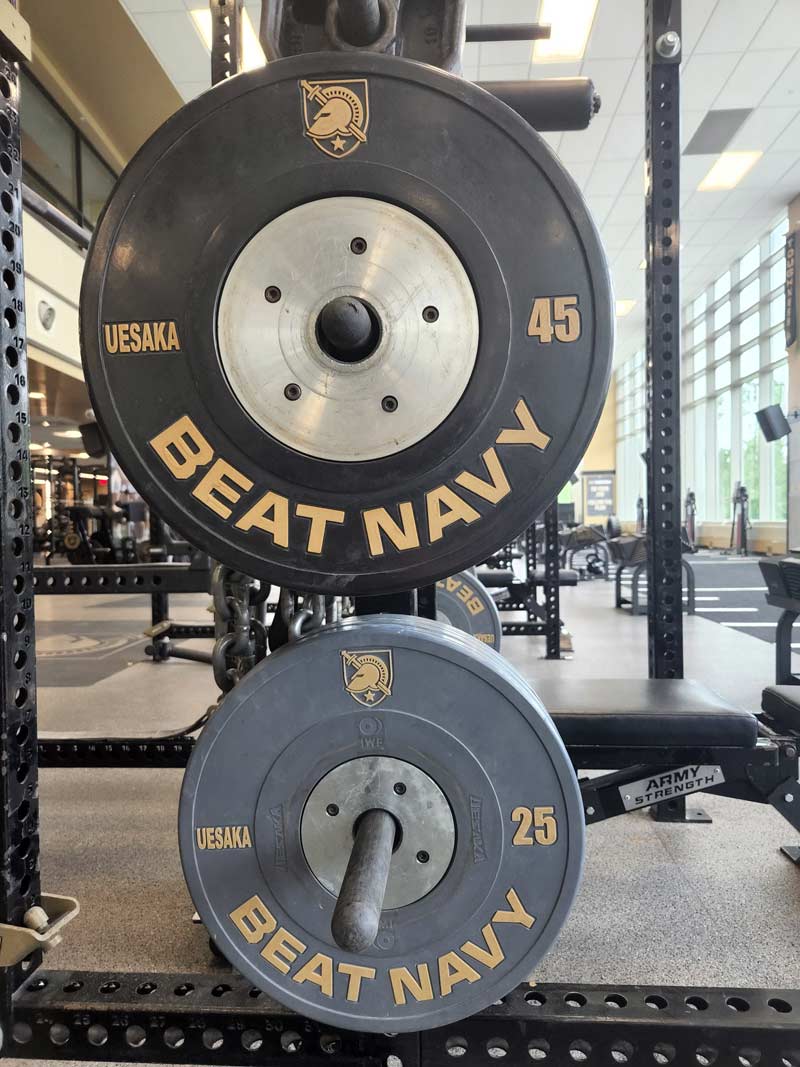
Takeaways
Coach Hughes was a valuable resource. I enjoyed getting to talk to him about all the little details that make his training facility special, and his passion for his athletes can be heard in the way he talks about the space.
“It needs to always work; you need to always be able to take your population from their origin to their destination,” Coach Hughes told me. “The fancier it is, the more likely you will have to make costly repairs: power windows break, but crank windows will always work. Build a solid base of equipment you know is always going to work, and as your budget increases, then get fancier.”
Power windows break, but crank windows will always work. Build a solid base of equipment you know is always going to work, and as your budget increases, then get fancier. Share on XThis idea gets lost many times because we all chase the “newest and best” without thinking about the longevity of equipment and products. Thank you again for following this series, and as always, if there are more details that I can pass along for ya’ll, please let me know!
Since you’re here…
…we have a small favor to ask. More people are reading SimpliFaster than ever, and each week we bring you compelling content from coaches, sport scientists, and physiotherapists who are devoted to building better athletes. Please take a moment to share the articles on social media, engage the authors with questions and comments below, and link to articles when appropriate if you have a blog or participate on forums of related topics. — SF

